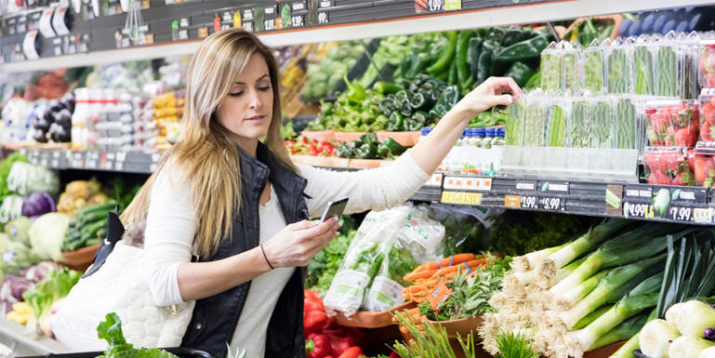10 Tips and Tricks for Buying Healthy Food

You avoided the rookie mistake of grocery shopping on an empty stomach by eating a fiber- and protein-rich snack. And being the savvy shopper that you are, you did your best to stick to the perimeter of the grocery store because that’s usually where the freshest whole foods are stocked.
So, exactly how do those chocolate chip muffins, the liter of lemon-lime soda, and that bag of crispy croutons manage to dive into your cart (along with that gossip mag with the cover story about the royal family)?
Despite entering grocery stores with the best of healthy intentions, it’s easy for things to go awry.
Enticing end-of-aisle displays are stacked high with bargain-priced soda packs, family-size potato chips, sweet cereals, and $1 cake mixes.
And even if avoid your particular Achilles heel of junk food, there’s still the challenge of figuring out your healthiest options — without spending a small fortune!
Luckily, there are plenty of tips, tricks, apps, and hacks to help make healthy shopping easier. Here are 10 of our favorites.
1. Scan Barcodes with Fooducate
Stumped about which brand to choose? Scan the barcode using the free Fooducate app to get instant intel, including an A to D health grade, nutritional notes, and suggestions for higher-rated alternatives (enter your zip code for even more customized recommendations).
2. Know the “Dirty Dozen” and “Clean 15”
If you’re wary of organic produce price tags, the Environmental Working Group’s Dirty Dozen and Clean Fifteen lists are great cheat sheets to help you weigh the options at a glance.
Based on USDA and FDA data on pesticide residue, these lists identify which fruits and vegetables have relatively higher and lower concentrations of pesticides.
Hint: Splurge on organic strawberries…
3. Plan Meals to Skip Junk Food and Save Money
The advice to plan meals is tried-and-true for good reason. Arm yourself with a list when food shopping; it’s a no-brainer to help you bypass temptations and stock your kitchen with plenty of healthy options.
Plus, meal planning can save you money by reducing food waste because you’ll ideally buy only what you need to prep and cook in batches.
4. Find Fresh Produce and Keep it Fresh for Longer
Knocking on watermelons, shaking blueberries, and smelling pineapples might seem strange, but they’re good ways to know if a food is ripe.
If you’re not sure how to tell, the Harvest app ($1.99) makes it easy with selection advice for over 120 produce items, storage tips for maintaining freshness, and information on pesticide residue levels to help you decide when to buy organic.
5. Look for Sustainable Seafood
Think you’re eating sustainable seafood? The list changes, so make sure with the Seafood Watch app from the Monterey Bay Aquarium.
Search by fish to get a straightforward overview, picks for the “best choice” and “good alternatives,” and recommended eco-certifications to look for on labels.
6. Weigh the Pros and Cons of Convenience
Sure, you’ll save time by purchasing pre-made foods such as salad dressings, dips, and fruit cups, but you can eat cleaner (and often lower your grocery bill) by preparing them yourself.
Need some healthy recipes to get started?
Try: 5-minute hummus, cinnamon raisin granola, homemade applesauce, and lemon tarragon vinaigrette.
7. Shop In-Season Produce
For ripe produce bursting with flavor and nutrients, spring for the local, in-season options that have spent less time in transit and storage before landing in your cart.
Discover which fruits, vegetables, and herbs are in season near you with Local Harvest or Sustainable Table’s seasonal produce guide. Your tastebuds will thank you!
8. Try Flash-Frozen Fish
Flash-frozen foods — which are frozen quickly at very cold temperatures in an effort to preserve as many nutrients as possible — can be less expensive than fresh, while still helping preserve vitamins and minerals.
Freezer-aisle fish fillets in particular are usually cheaper than fish-counter offerings (which often have been previously frozen as well).
Produce is less straightforward; frozen options may be less or more than their fresh, in-season counterparts.
9. Buy in Bulk
Another way to lower grocery costs: Buy healthy pantry staples in bulk. Items with longer shelf lives are good candidates — think grains, dried beans, nuts, and dried fruits.
Or, grab a larger value-priced size of a perishable item, and plan to make several dishes with it during the week.
10. Shop with Headphones
Does your grocery store play slow (or just bad) music? Down-tempo tunes in the supermarket may make you peruse more leisurely, and buy more.
Pop in some earbuds and listen to a more upbeat playlist and keep moving!
